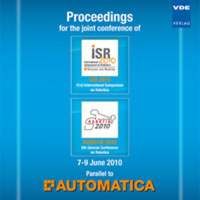A Humanoid Muscle Robot Torso with Biologically Inspired Construction
Konferenz: ISR/ROBOTIK 2010 - ISR 2010 (41st International Symposium on Robotics) and ROBOTIK 2010 (6th German Conference on Robotics)
07.06.2010 - 09.06.2010 in Munich, Germany
Tagungsband: ISR/ROBOTIK 2010
Seiten: 6Sprache: EnglischTyp: PDF
Persönliche VDE-Mitglieder erhalten auf diesen Artikel 10% Rabatt
Autoren:
Boblan, Ivo; Schulz, Andreas (Technische Universität Berlin, Fachgebiet Regelungssysteme, EN 11, Einsteinufer 17, 10587, Berlin, Germany)
Inhalt:
Human-like robots combine the optimized biological morphology and functionality of the real human with the mechanical constraints and limitations in the creation as well as possible. This will be a trade-off at all times. The best biological solution of a detail is often simple in the function but too complex for the technical analogue. The technical materials are often missing what make a one-to-one copy impossible. The combination of biology and robots leads to smoother and compliant movement, which is more pleasant for us as people. Biologically inspired robots embody no rigid movement, which are made possible by special joints, or actuators, which give way, and can both actively and passively, adapt stiffness in different situations. This paper present the humanoid muscle robot torso called "Zwei-Arm-Roboter" ZAR5 in human-like proportions and functionality, which is fully actuated by artificial air muscles. The first section gives a short introduction as to how Bionik engineers think in terms of compliant machines and whose technical realisation. The second section looks briefly at mechanical aspects, limitations and constraints and furthermore describes the human-like anthropomorphic five-finger hand. This section also comprises a short view of the used fluidic muscle actuators of the company FESTO. Section 3 describes the electronic components and the decentralized control architecture, which fulfils the requirements on an evolvable control. The last section concludes the paper.


